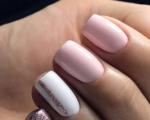How to sew a cotton skirt with your own hands. We sew summer skirts with our own hands: master classes for needlewomen with photos and descriptions of work
This summer season, maxi length is coming back into fashion - skirts will be floor-length. This is good news, because in a long skirt you feel cooler in the summer, especially if it is calico or cambric, and secondly, such a floor-length skirt allows you to visually elongate the lower part of the figure, making your legs endless!
Another argument in favor of a floor-length skirt is that you can sew it without a pattern, literally in an hour. So, time has come!
Maxi skirts can look completely different. We suggest you sew a skirt consisting of three frills of the same width. The length of such a skirt depends on the width of the frills, which are determined by the formula: Divide the length from the waist to the floor according to the measurement by 3.
For example, the length from the waist to the floor according to the measurement is 105 cm, the width of each frill will be equal to - 105: 3 = 35 cm.
Constructing a pattern
Pattern modeling
Skirt belt pattern.
Measure your waist circumference. Draw a rectangle equal to the length of the waist circumference according to the measurement plus a 3 cm increase for the fastener. The width of the rectangle is 8 cm. The increase in seams is 1 cm on all sides.
Pattern of the first frill of a floor-length skirt.
Calculate the width of the frills using the formula - the length from the waist to the floor according to the measurement, divided by 3. Draw a rectangle with a length equal to the waist circumference multiplied by 1.4-1.7 (the larger the number, the more magnificent the ruffle) and the width obtained from the formula - in our case - 35 cm.
Pattern of the second frill.
Draw a second frill of the same width and length equal to the length of the first frill multiplied by 1.6-1.7.
Pattern of the third frill.
Draw a third frill with a length equal to the length of the second frill, multiplied by 1.6-1.7. Pay attention to the allowances on all sides - 1 cm.
Floor-length skirt pattern: cutting
We told you in detail how to calculate fabric for a full-length skirt and other clothes. See:
Lay out all the details of the skirt along the grain, allow seam allowances of 1.5 cm, and 3 cm for the bottom frill.
How to sew a skirt
Sew the upper sides of each frill with a wide stitch (4 mm) and pull together.
The length of the top frill should be equal to the waist circumference according to the measurement, the length of the second frill should be equal to the lower edge of the first, and the length of the third frill should be equal to the lower edge of the second frill.
Baste and stitch the frills together. Process allowances. Sew a hidden zipper along the back seam of the skirt into the floor.
Reinforce the outer side of the stitched belt with thermal fabric.
Fold the bottom of the skirt to the floor by 1 cm and stitch.
You can also stitch each frill along the top to the edge and two lines below (at a distance of 0.5 cm from each other - see photo above), carefully straightening the folds.
A skirt is a must-have item of clothing in every woman's wardrobe. Short and playful, long, strict, pleated, flared and tapered at the bottom - they can be completely different, but all as one emphasize femininity and make the image unique. The fact that fashion does not change at all, but only repeats itself, is a fact that has long been known to everyone, and today the full-length skirt, the pattern of which will be given in this article, is again at the peak of popularity.
Where to start making a pattern
The template for cutting this item of clothing is very easy to construct. To work, you will need thick construction film (newspaper, a roll of wallpaper or glued sheets), a pen, a ruler, a measuring tape and scissors. Each panel is built separately. So, where to start to get a perfectly fitting floor-length skirt? The pattern is based on the measurements taken: waist, hips and length of the product from the waist to the bottom of the hem.
Straight Skirt Front Panel Template
After the measurements, you can begin working directly with the drawing. To do this, draw a vertical line on the base for the workpiece, equal to the length of the product from the waist to the bottom. Then you should mark the lines of the hips and waist. The distance between them is usually 15-20 cm. Next, the so-called horizontal measurements should be divided in half and the resulting values should be plotted at perpendiculars to the vertical line of the drawing. Usually, darts are not made on the front panel, especially if the stomach has a convex shape.
In this case, only the curve of the back is highlighted. This means that in order to finish working with the front panel, you should draw a line along the waist line from the side seam to the middle, cutting off the top of the product by 1.5 cm. Afterwards, a smooth line is drawn along the side cut, connecting the line of the waist and hips and going straight down. Both winter and summer floor-length skirts are built using this principle. The length of the hem can also be adjusted.

Straight skirt back panel template
It should be said that a straight floor-length skirt is the easiest to construct, and other styles are modeled based on its template. Creating a template for the back panel differs only in that 0.5-1.5 cm is added to half the measurements for a loose fit, depending on the density of the fabric and the design of the darts. It is these fabric tucks, evenly distributed along the waistline of the back panel, that allow you to adjust the fit of the product so that it follows all the curves of the figure. So, in order for the skirt to fit like a glove, putting aside half the waist circumference measurement along the upper perpendicular, you should add 3 cm. After this, they should be distributed into the darts between the middle and side seams.
Sewing a straight skirt
Making a floor-length skirt with your own hands is quite simple. After all the patterns are ready, they can be transferred to the fabric using soap or tailor's chalk. When cutting, allowances for processing seams should be taken into account. The assembly of all parts begins with processing the middle seam of the rear halves, where a zipper is sewn along the top, the seam is closed in the middle, and a cut is made at the bottom for free walking. Then close the darts and start sewing the side seams.

The final stage of processing is stitching the belt and processing the bottom of the hem.
Calculation of fabric for a circle skirt
The floor-length circle skirt has become quite popular today. It is cut quite simply. The template consists of two semicircles of fabric. To get a beautiful floor-length skirt, the pattern of which will be discussed below, you should correctly calculate the fabric, draw the contours and design the cutout for the waist.
To begin with, it should be said that the process of constructing a blank is best done directly on fabric, the width of which should be at least 1.5 meters. All main construction will be done on one of the edges; side cuts will also be made on the tight edge. If it is a thin fabric, then these sections may not be processed during the assembly process. If the edges tighten the fabric somewhat, they should be cut off and, when sewing, the cuts should be processed with an overlocker. By the way, a full-length circle skirt will look ideal made from soft flowing fabrics, but thick fabrics will not be suitable for such a model.

So, to calculate, you need to take into account the length of the product from the waist to the bottom + 5 cm for processing and + a quarter of the waist measurement. Thus, one product will require 4 lengths + half the waist circumference + 20 cm.
Constructing a pattern
As already mentioned, construction is carried out along the edge of the canvas. The length of the product + 5 cm is set aside from the edge, then ¼ of the waist measurement and again the length from the waist to the bottom. After the middle of the short segment, ¼ of the waist measurement is set aside perpendicular to the edge and the three marks are closed in a semicircle. Next, you need to draw a semicircular line along the bottom of the hem of the skirt. To do this, you will need a measuring tape, with which marks are made at a distance of every 20 cm (from the waist to the bottom according to the length of the product +5 cm). Afterwards, all marks also close in a semicircle. It is necessary to make an allowance for processing along the cutout of the waistline.
The full-length circle skirt is sewn from two absolutely identical parts. The waistband is a narrow strip of fabric, and the zipper is sewn into the left side seam.

Fashion is medicine for women
Every fashionista tries to follow the latest trends dictated by glossy magazines, and if you have even the slightest ability for needlework, then making such a thing as a floor-length skirt with your own hands will not be difficult and will not entail large expenses. A little diligence, patience, imagination - and a unique product will become your favorite item of clothing. The floor-length skirt, the pattern of which is presented in this article, will become an indispensable outfit for a summer walk or an evening out. The main thing is to choose the right fabric and “work a little magic” with the sewing machine. The result will exceed all expectations, and admiring glances will give you self-confidence and the desire to continue creating unique masterpieces.
Sewing a simple floor-length skirt is not difficult even for a novice craftswoman. After all, you can do without a pattern; it will be enough to take just a few measurements. In this article we will analyze in detail what needs to be measured and how, how to cut out parts and sew. For those who don’t want to bother with drawing, I offer ready-made free patterns for a long skirt, which can be downloaded at the end of the article.
How to create a floor-length skirt pattern
First we need to decide on the fabric. It is desirable that it stretches in the transverse direction. Otherwise, the skirt will hinder movement.
Required measurements:
- Waist circumference,
- Hip circumference (optional measurement, needed for verification),
- Length from waist to outer foot.
- Step length (needed so that the skirt does not hinder movement).
With the first three measures, I think there should be no questions. But to measure the length of the step, or rather, it would be even better to say the circumference, you need to take your usual step and measure the circumference with a centimeter tape, clasping your ankles.
On fabric folded in half, set aside a quarter of the OT on top, for example, if your waist is 68 cm, then you will need to set aside 17 cm + seam allowance.
We set aside the length along the fold line, for example 90 cm. From the resulting point we set aside a quarter of the step circumference. So, if your measurement of this value was 88 cm, then you will need to set aside at least 22 cm. Of course, you can measure more, but if you take a smaller segment, keep in mind that walking in a skirt will not be very comfortable. To correct the situation, you will have to make a cut, but we sew without it.
Finally, check to see if the skirt is tight at the hips. To do this, measure approximately 18-20 cm below the waist and measure the width in this area, it should be at least a quarter of the circumference of your hips. If you have a narrow waist and very wide hips, you will have to slightly increase the waist mark and increase the width of the lower section by the same amount.
Method No. 2. According to the method of Marlene Mukai.
Marlene Mukai suggests creating a long skirt pattern using the hip circumference as a basis. Below are drawings of such skirts. We see that initially a rectangle is drawn, the width of which is a quarter of the OB. We measure a quarter OT from the top, and another quarter OB is laid down from the edge of the rectangle. The edges of the skirt need to be slightly rounded. In my opinion, Marlene Mukai’s patterns are one of the most accurate and at the same time simple. By the way, all measurements in the drawings are indicated taking into account allowances. Size chart below.







How to sew a maxi skirt
Cut out the pattern pieces. Place them right sides together and sew the side seams. Fold the bottom.
To process the top, cut a strip of fabric, the length of which will be equal to OT, the width will be approximately 20 cm. Fold it in half and sew it to the upper section of the skirt. If you have very wide hips and the fabric is not elastic, you can cut a longer strip and then insert an elastic band into it or sew on rubber veins.


Other options for maxi skirts
Here are some more options for long skirts. The size chart for these drawings is the same as for the Marlene Mukai patterns.









Hi all!
No matter how hard I try to write regularly, summer is taking its toll... The weather is hot outside, and it’s simply not possible to sit at home! And when I’m at home, I spend them taking courses (which I signed up for half a month ago...), which take a lot of effort, time and labor.
But today I decided to do a little lesson. The idea arose for a reason, but after another walk around the city :) I saw one girl wearing a very beautiful long skirt with pleats...
And I liked it so much that I decided not only to sew it, but also to show the idea to you!
Pattern of a long skirt with elastic
The girl's skirt was a very beautiful sky color. And it fit perfectly on her figure... Unfortunately, I didn’t find such a model on the RuNet (maybe I didn’t look well), but now I’ll describe and show it in great detail.
In this tutorial we will look at two models.
The first model is very simple and light and it won’t be difficult for you to make it. This Pattern for a long skirt with elastic:
You will probably be very surprised, but there will be no pattern :) Why? But we just don’t need it!
In order to sew such a skirt, we only need two measurements, a ruler, a chalk and a piece of fabric.
Now I’ll tell you in detail how to do a miracle called “pattern for a long skirt with an elastic band”.
First, let's take some measurements:
- waist circumference
- hip girth
- length of the product
If you are not yet familiar with how to correctly take these measurements, then take a closer look.
But I’ll write briefly here: we take measurements in underwear by tying a lace at the waist. Using it around the waist, we take measurements of the waist circumference. And then from the lace to the floor - this is the length of the future product. The hip circumference should be measured at the protruding points of the buttocks.
After taking the measurements, we move on to the fabric for the floor-length skirt. 
The usual fabric width is up to 150 cm. Therefore, it is important to know that:
- for hip circumference up to 100 cm - take the length of the product (which was taken from the waist to the floor or the desired length) + 10 cm.
- more than 110 cm - two skirt lengths + 10 cm.
First, we make a belt with an elastic band:
To make it, we need to tuck the top edge of the skirt to the width of the belt + seam allowance. But don’t confuse the width of the skirt with the length! So that you don’t get confused about what’s where, I’ll tell you a little trick: each fabric has a selvage (this is the seal of the fabric along its edges), this will be the width of the skirt. Just what we need 😉
For example, it will be equal to 3 cm. This means 3 cm + 1.5 cm (allowance) = 4.5 cm.
We sew in the seam allowance that we just made at waist level (3 cm from the top). We pass the elastic inside.
We try on a skirt and make a tight belt to fit the figure (we tighten the elastic band so that it does not sting or dangle). Tie the ends of the elastic band or sew them on top of each other using a typewriter.
Then we make a hem at the bottom.
Don’t take too much for the hem, but remove enough so that you get the desired length of the skirt (if it’s more than 4 cm, it’s better to cut off the excess).
Then the final touch is the back seam of the skirt. That is, a seam along the length of the product.
That's all! :)...
Pattern of a summer skirt to the floor
Now the second model is a pattern for a floor-length summer skirt with pleats.
The construction principle is still the same. But now we will not collect the extra width with an elastic band, but will put it in beautiful parallel folds.
I’ll tell you in more detail how to do this:
- Since the width of our fabric is 150 cm, we subtract the waist circumference from it. In my case it will be: 147 (3 cm for seam allowance along the length of the skirt) cm - 87 cm = 60 cm. I must hide this figure in the folds.
- Now let's decide on the belt. Here we will have it cut off. Therefore, from our piece of fabric we cut a strip equal to: belt width * 2 + 2-3 cm for allowances, and a long strip equal to waist circumference + 3 cm.
- Let's decide on the number of folds: there will be 8 of them (4 each in front and back). This means 63 cm / 8 folds = 7.8 cm per fold.
- Next you need to lay them on the fabric. To make it beautiful and symmetrical, divide 150 cm by 9. Why 9? Since we have 8 folds, we should have 9 equal sections (the formula is: number of folds + 1). Next, divide the waist circumference by 9: 87/9 = 9.6 cm - the distance between the folds.
- We begin to lay it as follows: from the edge of the fabric, 1.5 cm wide (½ seam allowance), then a 9.6 cm vertical chalk line - the beginning of the fold. Then set aside a fold width of 7.8 cm. Another line is the end of the fold. And so on until the end of the fabric width. Secure the folds with safety pins.
- Sew the belt to the skirt. To begin with, we fold it into pieces. and sew it to the top of the skirt (with folds in place!).
- We sew in a hidden zipper (grabbing the belt).
- We make a vertical seam along the length of the skirt.
- Last step: hem the bottom!

A long skirt, depending on what material is chosen for it, what it is made from, is fashionable, stylish and, let’s say, “on theme” for any season of the year, and for different occasions.
1:866 1:875

3:8

By and large, what should be the pattern for a long skirt?
4:634 4:643The pattern of long skirts can be made using the pattern of any skirt. This is explained by the fact that the skirt that you like is modeled, as usual, the only difference is The length of the finished product must be increased to the required length!
4:1050 4:1059
5:8

For example, a pattern for a floor-length skirt based on a pattern or (they are similar) - everything is as usual. And make the length that you need - be it short, medium or long.
6:895 6:904
Here is another option for a floor-length skirt pattern- based
7:15477:8


The model is always in fashion, looks great at any length, the main thing is to choose good material.
9:1209 9:1218
Also, depending on the modeling method, you can make a skirt with a high waist or with an elastic band, which is most likely the easiest option for a novice seamstress or dressmaker.
10:349 10:358
Perhaps you like it, and if you also want pockets, then you should sew on pockets, it will turn out both stylish and comfortable.
11:1151 11:1160 12:166412:8
You know, I really, really like the trouser skirt - it’s both feminine and with a touch of courage, casual and very festive. In fact, in my opinion, this is a useful invention for a woman’s wardrobe, it allows you to combine convenience and style. How to sew it, you can
12:563 12:572
Useful and easy to understand, I’m sure it will help you a lot.
13:1379 13:138813:1393 13:1402
Skirt Romantic
13:1442 13:1451
14:8

It can simply be elastic, straight and long, then the pattern of such a skirt is extremely simple
15:690 15:699
You can take a rectangle of fabric and an elastic band that is as long as your waist or hips, it depends on how you will wear it later. And then, having slightly gathered the fabric, we sew it to the elastic band, first making only one side seam. We process the cuts and that’s it!
16:168616:8


It will certainly turn out very beautiful and stylish if you take corrugated fabric.
18:1178 18:1187Here is another pattern for a long skirt with wedges
To do this you will need about 170 centimeters of fabric with a width of 140 centimeters and a zipper.
18:1441 18:1450
On the pattern, the two upper parts are the front and back middle parts of our skirt, and the lower parts are wedges, of which there will be two of each. At the very bottom is the belt.
19:340 19:349
In general, a long skirt is any skirt, be it with a wrap, with a yoke, with an elastic band, with a peplum and pockets, the only thing in common is the length, that is, we look at the pattern of any skirt pattern we like, and increase the length of the skirt itself to the desired us size. That's all.
20:1375 20:1384 20:1387 20:1396


